
The unimaginable: Haiti Solar Oven Partners reflects on 2010 earthquake
On January 12, 2010, at 4:53 pm, a 7.0 earthquake struck Haiti, 16 miles west of Port-au-Prince, the capital city with an urban population comparable to Chicago. In this most fragile country in the western hemisphere, infrastructure necessary to respond to the disaster was severely damaged or destroyed—all hospitals in the capital; air, sea, and land transport facilities; and communication systems. Terrified people ran to open spaces as the tropical darkness came quickly. Scenes of unimaginable suffering were revealed by morning light.
An estimated three million people were affected by the quake with death tolls ranging from 160,000 to 220,000 and more than 300,000 injured. The quake destroyed the equivalent of 120% of Haiti’s GDP.
Members of Haiti Solar Oven Partners, Rick and Lorna Jost, Gene Fastnacht, and Donna Fisher, share their experiences five years after the earthquake.
Jost and HSOP assist with UMCOR response
Lorna Jost, Coordinator of North Central Jurisdiction Volunteers in Mission was in Haiti soon after the earthquake. She helped develop the Haiti Response Plan Proposal to secure UMCOR funding. UMCOR launched a three-year partnership between UMCOR, EMH (Methodist Church of Haiti) and UMVIM to coordinate recovery efforts.
The following paragraphs are Lorna’s recollections of the work of UMCRO immediately following the earthquake.
After the earthquake and the loss of Rev. Clint Rabb, our liaison at the General Board Global Ministries, the five Jurisdictional UMVIM Coordinators realized that UMVIM would have to be a force in rebuilding the Methodist Church of Haiti (Eglise Metodiste Haiti, EMH).
Three of us headed into Haiti in February 25 – March 3 2010, two months after the earthquake. Greg Forrester, NEJ; Paulette West, SEJ; and myself, NCJ were able to go and represent UMVIM. (Greg Forrester is now UMCOR Disaster Response Coordinator for the USA). All of our jurisdictions had multitudes of volunteers that regularly served in Haiti and knew that there would be a lot wanting to go down, whether Haiti was ready for them or not!
We took our own pup tents, very few clothes, and slept on the ground in various locales all around Haiti, touring the Methodist Churches and buildings that would need to be rebuilt. It was all a bit eerie, as aftershocks were still being felt, and as we lay down to sleep at night, the sounds of the shocks and the feel of the earth grumbling were ever present.
Montas Joseph, Haiti Solar Oven Director, was enlisted to drive us around in the Haiti Solar Oven KIA truck and we slept in Ramonde’ and Montas’ yard for a few of the nights. Their house was damaged and I carried a big tent down from HSOP for their personal comfort.
We met with Rev. Gesner Paul, President of the EMH and this is where the Haiti Response Plan, utilizing UMVIM teams was conceived and formulated.
The Haiti Response Plan, administered by Mission Volunteers office of GBGM, involved a coordinator for calendaring in the USA, employment of Haitian workers on the project sites, and maximizing use of the Haiti Guest House. It was well received as noted by the number of projects rebuilt and the number of volunteers responding from across the USA. Gene Fastnacht, Wessington Springs, and I led several teams to Haiti from the Dakotas through this plan from 2010-2013. This plan was officially closed in the fall of 2013 with the Haitian church coordinating teams as it did previous to the earthquake.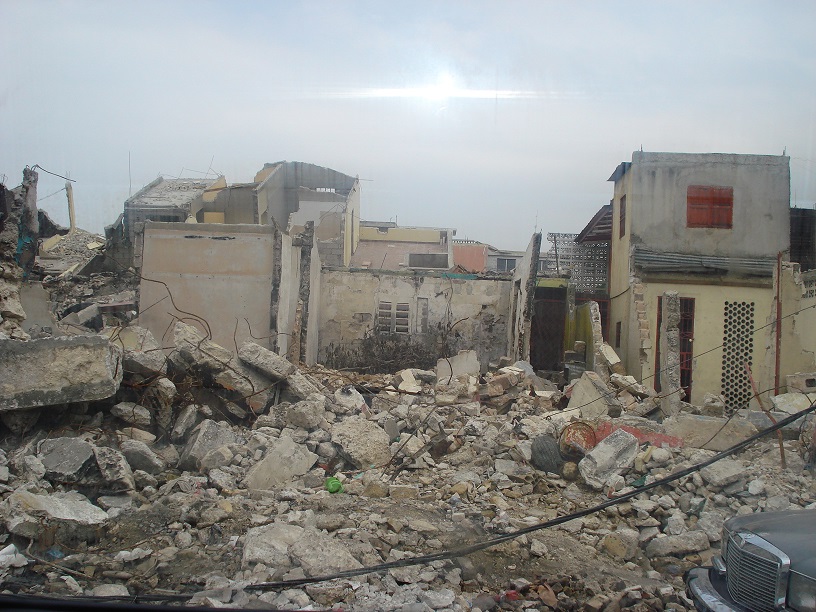
Photo: Living in the Rubble –Photo by Lorna Jost, late February 2010): “I could not get over the damage - it was heart-numbing, unimaginable… The Haitians were still digging out, moving rubble, finding bodies… but we knew there was a need for bringing them Hope –hope that there could be a future for Haiti and her people. Haitians were living in a nightmare that would not go away…ever!” -Lorna Jost
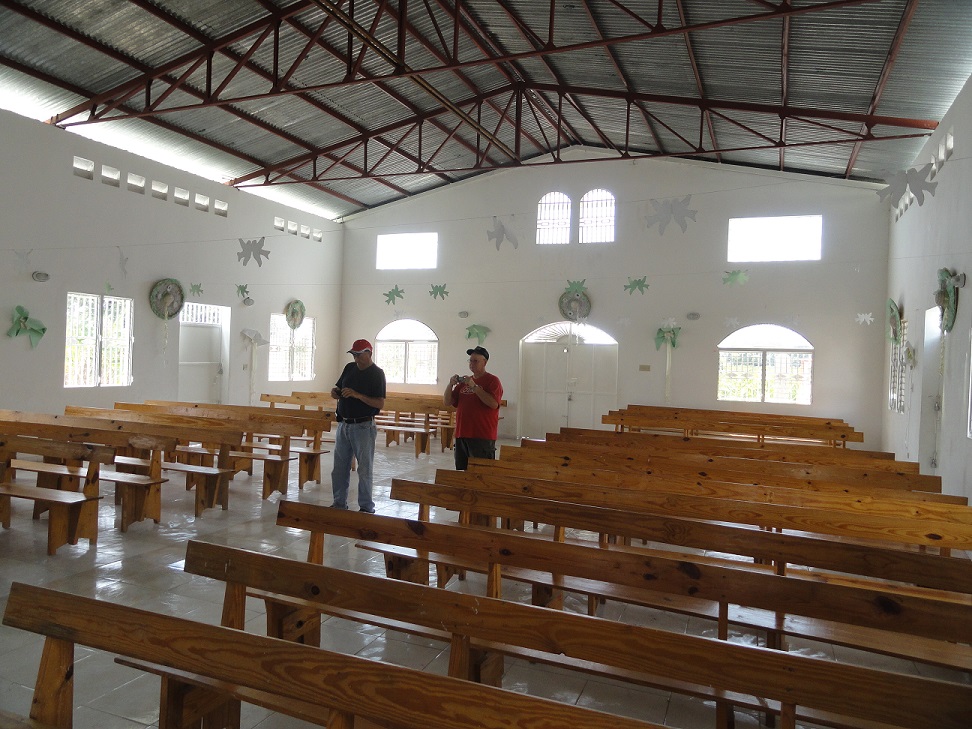
Photo: Arcahaie church rebuilt 2012. Photo by Lorna Jost “Volunteers paid for their own costs of travel, food and lodging plus some project funds. These project funds were then matched with UMCOR funding used as incentive to promote the projects. The volunteer investment in the rebuilding process was huge!” -Lorna Jost
I learned more than I could imagine…
Gene Fastnacht, Wessington Springs, traveled to Haiti many times before and after the earthquake. During Easter 2010 Gene joined that effort to provide carport and tent shelters for our Haitian staff and a few others. He and Lorna Jost led several teams to Haiti from the Dakotas under The Haiti Response Plan from 2010-2013.
“Before Rick and I left for Haiti I was trying my best to wrap this earthquake situation around my mind. Never having witnessed one before, I thought I had a pretty good handle on what I would witness, having seen many pictures on the television. I had no idea!
The first thing you realize is the country is much quieter, noticeably less people on the streets, and the devastation is unexplainable. People living in the median on the divided highway in Carrefour, with trucks driving by just outside a cardboard or tin shack!
The Haitian people have always amazed me with their ability to survive. I remember the Easter service Rick and I attended. Pastor Ralph was asking the congregation why they were not praising God for all the blessings. I kept asking myself, could I really be this strong in faith! I have learned so much about my faith in God by walking with my Haitian family.
God is with us in the darkness….
Donna Fisher of Canyon Lake United Methodist Church in Rapid City, South Dakota travelled to Haiti in 2011 as a volunteer with a team from Haiti Solar Oven Partners. She reflects on her experience one year after the earthquake.
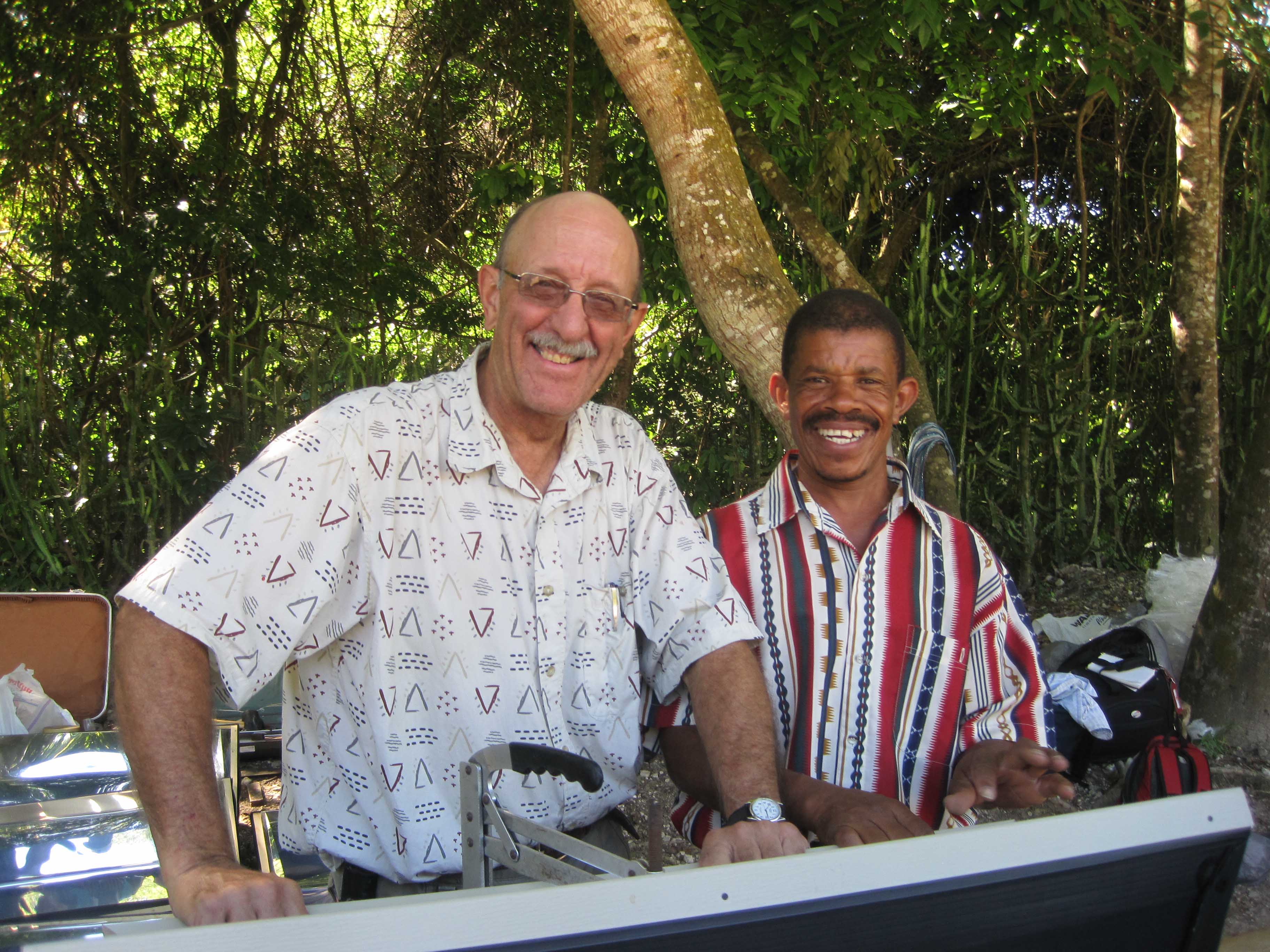 Do you remember the first news reports? The horrific photos and stories made more personal as we learned that UMCOR officials (Sam Dixon, head of the United Methodist Committee on Relief and Clint Rabb) were among the dead. Because of Haiti Solar Ovens, this 2010 earthquake became intensely personal for many of us. We had a medical team on LaGonave during the quake. Haitians survived two centuries of natural, political and economic disaster but this was damage of unbelievable scope.
Do you remember the first news reports? The horrific photos and stories made more personal as we learned that UMCOR officials (Sam Dixon, head of the United Methodist Committee on Relief and Clint Rabb) were among the dead. Because of Haiti Solar Ovens, this 2010 earthquake became intensely personal for many of us. We had a medical team on LaGonave during the quake. Haitians survived two centuries of natural, political and economic disaster but this was damage of unbelievable scope.
Photo: Gene works with Haitian oven builders. “The country is better, stronger; it is coming back piti piti —a little bit at a time. With help they will survive, they are strong; they have a deep faith and I love them dearly.” ~Gene Fastnacht
When I went to Haiti in mid-November 2011, I thought I was mentally prepared to see devastation as well as rebuilding. Miles of tents and makeshift shelters marked with familiar logos of UNICEF, OxFam, Red Cross indicated that people around the world were trying to help, but heaps of rubble, a fog of dust and miles of collapsed buildings belied progress.
Realistically, how could a billion plastic bottles of water or our suitcases of medical supplies for Grace Children’s Hospital make a difference in the one-step-forward, two-steps-back reality of Haiti? Would Haiti ever recover from this awful destruction, even with the world resources continuing to pour in? Photo: Edge of Cite Soleil, November 2011. Photo by Donna Fisher
With dusk falling quickly and no electric service for my first tropical night in their recently repaired home, I asked Haitian Director Montas Joseph if there was hope. I’ll never forget his gentle reply. “Perhaps it is best that this suffering fell on us here in Haiti because we may be better prepared to face it. When the world collapses on us and darkness covers us, we know from experience that God is with us in the darkness and will never leave us. Perhaps, you in the States do not know so much that from experience."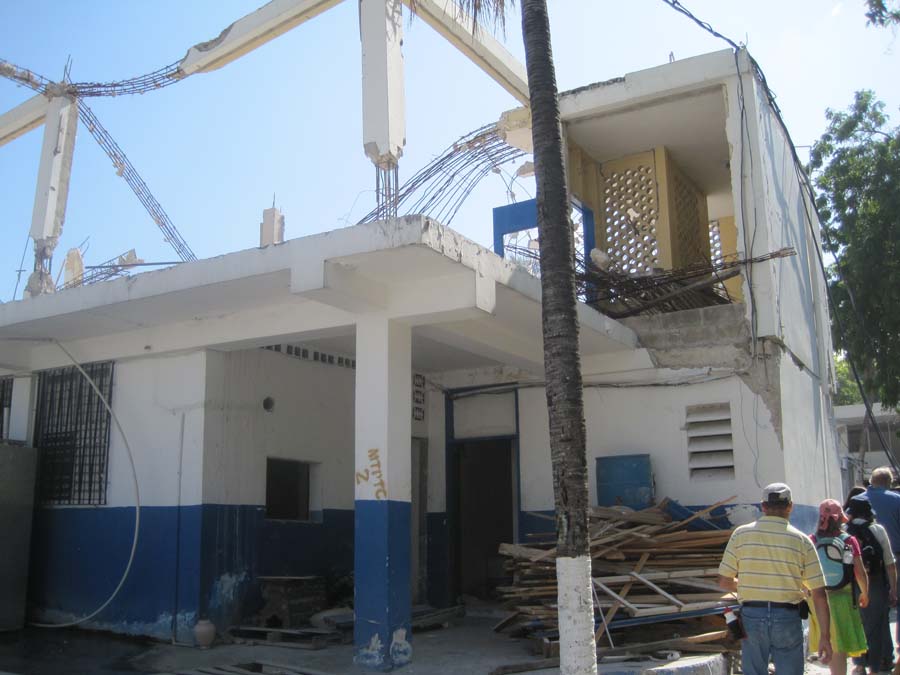
What I saw in my 10 days in Haiti were faith, wisdom, grit, resilience, realism, joy and amazing hospitality. It’s what HSOP volunteers see in trip after trip. There is no romance in destruction and poverty, but there surely was and is God’s healing presence.
Photo: November 2011 VIM team passes ruins of Grace Children’s Hospital, the largest children’s facility in Haiti, devastated by the quake. For several years, VIM teams brought supplies to assist staff working out of re-purposed sea containers. The hospital has rebuilt and expanded outreach to tent communities near the hospital. Photo by Donna Fisher
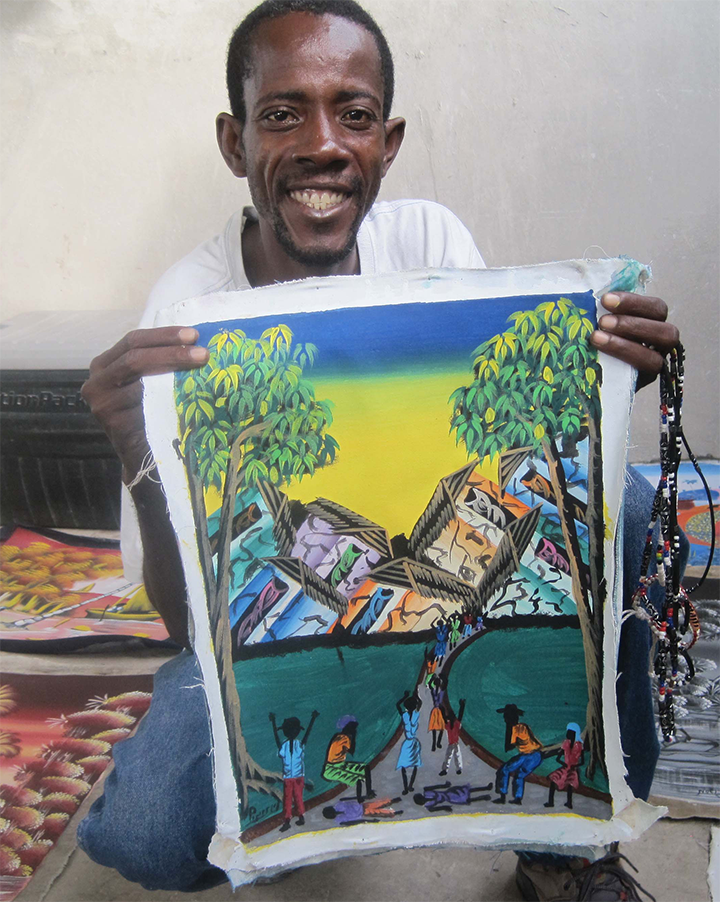
Photo: The work of Pierre, a Haitian folk artist, shows the terror of the earthquake victims as his painting captures grief and death. Photo by Donna Fisher
Haiti Solar Oven Partners five years later
Rick Jost, Director of Haiti Solar Oven Partners, reflects on five years since the quake and where we’ve come.
My sense of what happened to our Haitian partners during the earthquake is one of devastation—then fighting back. While we have all seen on TV the survival mode that kicks in after disasters, in Haiti it was nothing if not extraordinary, especially in the face of the enormous death toll.
The loss of the ways and means of daily life among survivors was particularly harsh in the geographic areas where HSOP had been working. The earthquake’s epicenter was very nearly at the location of the residence of our project and training directors, Montas and Raymonde Joseph.
At the time of the quake, we estimated that of the 3601 ovens we had placed, 2074 were in the earthquake-devastated area (Port-au-Prince, Cite Soleil, Carrefour, Petit Goave, Jacmel, etc.). This accounted for 57.6% of the ovens, which we sadly expected were flattened, crushed or left behind in the outward migration of folks from the heavily populated areas, and/or the owners killed in the quake.
Photo: The worst of the earthquake’s damage occurred in areas where our solar cooking training seminars had been taking place. Photo by Rick Jost.
Another 588 ovens or 16.3% were in the countryside that had some quake damage, but not as extensive as the cities. Together these two groups accounted for 74% of the ovens distributed over a 10-year period.
HSOP has been blessed to cast a wider net and train growing numbers of solar cooks since the earthquake. It was not until 11 months after the quake that our regular UMVIM teams—who supported the training/assembly/distribution of ovens—could resume. During those 11 months, proof of the capacity of the Haitian staff to carry on laid the foundation on which growth of our program has been built.
Photo: Our Haitian staff endured exposure to the elements—including aftershocks, heavy rains, very hot daytime temperatures—without shelter. In short order, donors responded with gifts to our Haitian Employee Quake Recovery Fund for the purchase of near-term shelter needs (car ports and tents), as well as rebuilding needs for permanent housing.
Photo: Here the Montas Joseph family stands near the shelter provided by the Employee Recovery Fund. The Joseph home, repaired and expanded, continues to provide hospitality for HSOP teams coming into and out of Haiti.
Beyond the loss of so many of our original ovens, the greater impact in Haiti was the loss of lives, property, and the blow to the human spirit of an already marginalized population. As this was ongoing, our Haitian staff began ramping up the training and distribution of solar ovens, which proved their capacity for growing the program even without the presence of supporting UMVIM teams.
Amazingly, on the fifth anniversary of the earthquake, we are nearing a total distribution of 10,000 solar ovens. We are closing in on an annual distribution rate of twice the pre-earthquake rate, which was the goal that our board envisioned immediately after the disaster. We have not yet reached our capacity, but with the help of all of our partners, we continue on a path of meaningful growth.
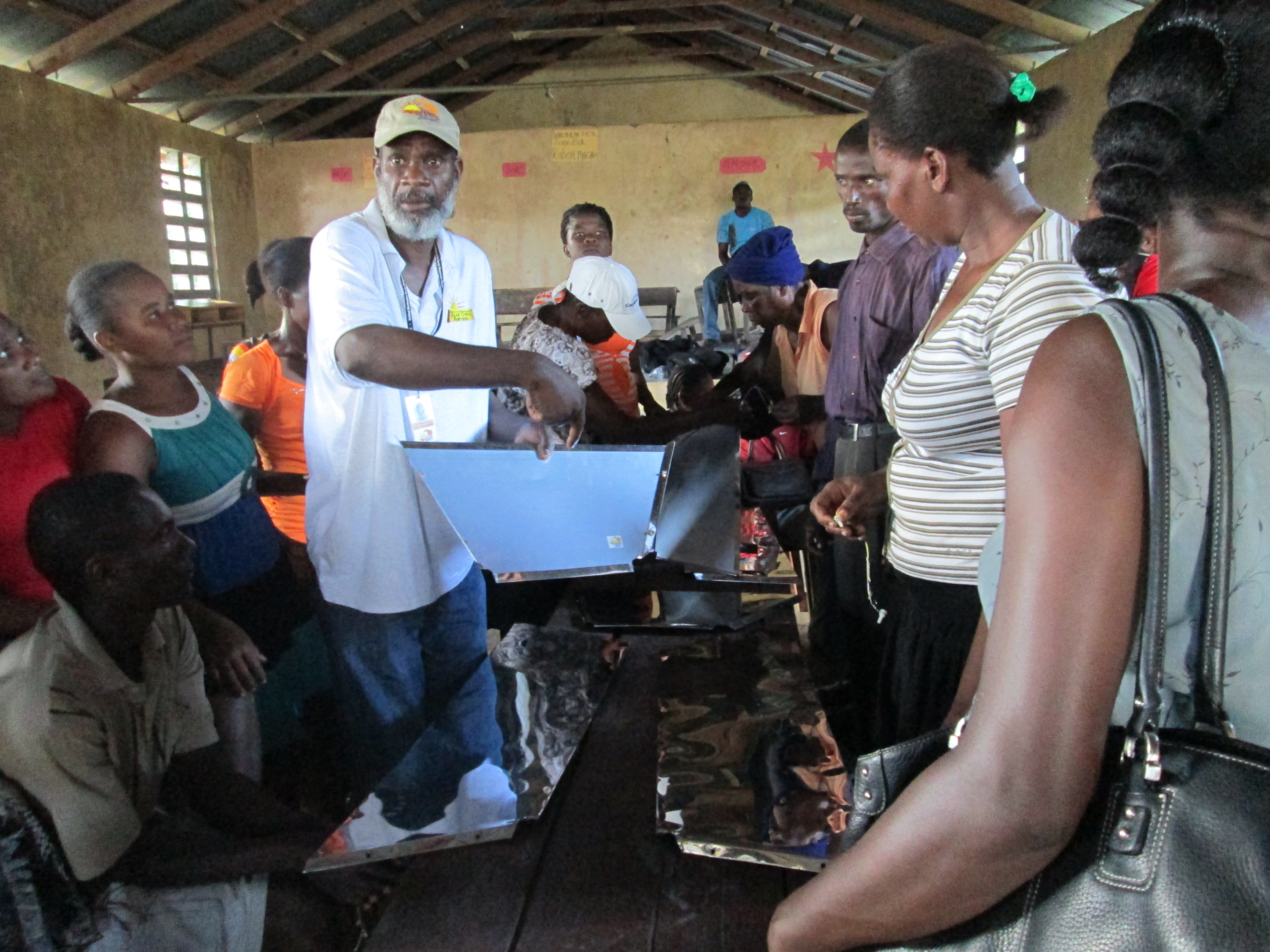
Photo: Montas Joseph instructs on care of the new aluminum reflectors. Photo by November 2013 team member.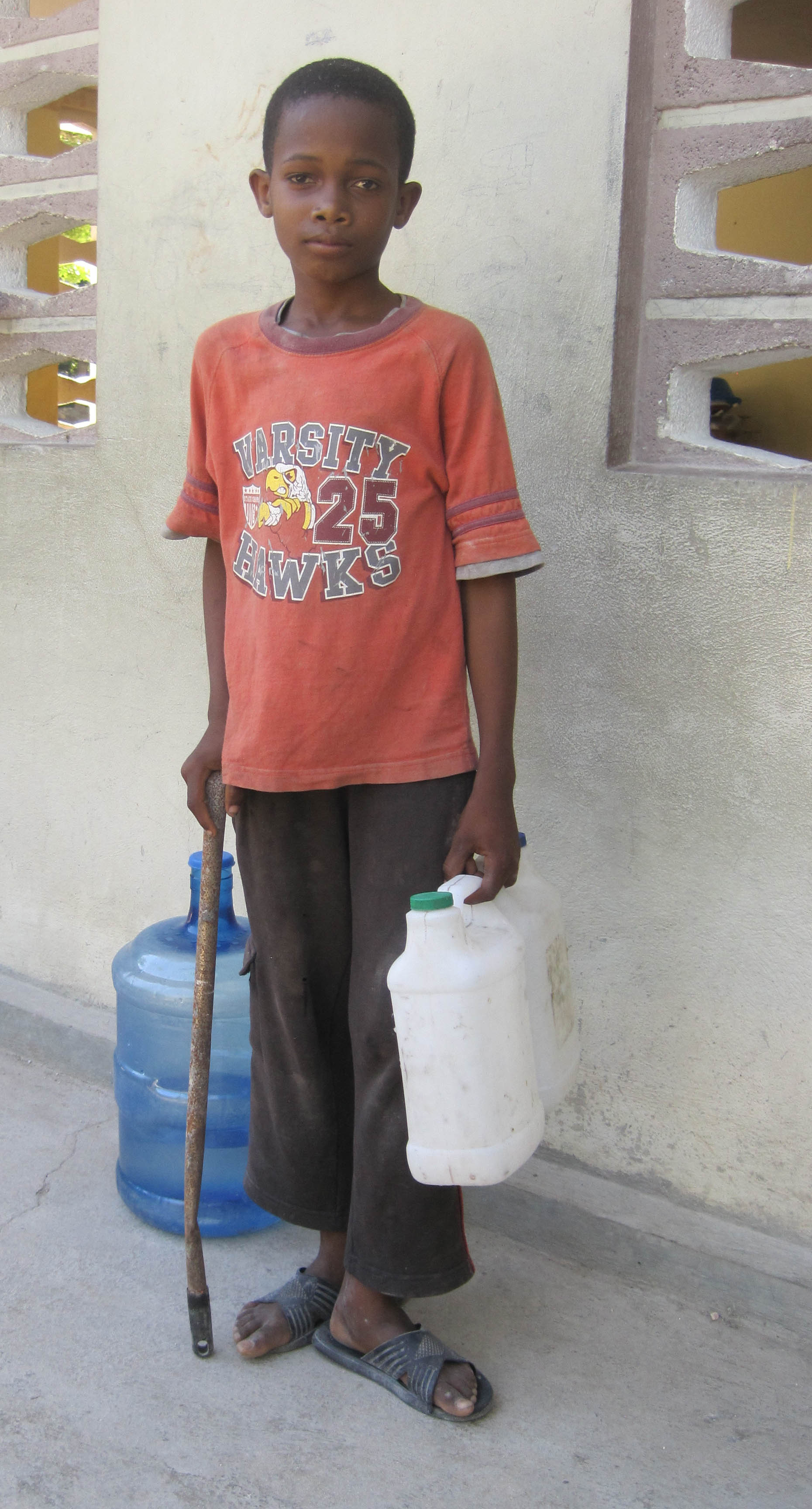
Photo: “Five years after the earthquake, the death and devastation still weighs heavily on the Haitian psyche, especially those million or so who actually experienced it. Though the rubble is largely gone, there is still a good deal of rebuilding to be done or that may never actually be done. The wave of homelessness that swept in is less and less visible, but many argue that the combination of pre- and post-quake homelessness is far from being mitigated. In short, compassionate, self-help ministry still stands in the gap between an impoverished population and the society’s ability to overcome the grinding poverty.,” ~Rick Jost Photo by Donna Fisher


